A Novel N-Sulfonylamidine-Based Derivative Inhibits Proliferation, Migration, and Invasion in Human Colorectal Cancer Cells by Suppressing Wnt/β-Catenin Signaling Pathway
Abstract
1. Introduction
2. Materials and Methods
2.1. Chemicals and Reagents
2.2. Cell Lines and Cell Culture
2.3. Cell Proliferation Assay
2.4. DAPI Staining
2.5. Flow Cytometry Analysis of Apoptosis
2.6. Mitochondrial Membrane Potential Assay
2.7. Transwell Assay
2.8. Wound-Healing Assay
2.9. Real-Time PCR Analysis
2.10. Immunofluorescence Staining
2.11. Western Blot Analysis
2.12. Docking Studies
2.13. Statistical Analysis
3. Results
3.1. 26ag Inhibits Colorectal Cancer Cell Viability and Induces Apoptosis
3.2. Effects of 26ag on the Expression of Apoptotic Proteins and mRNA in HCT-116 Cells
3.3. 26ag Suppress Migration and Invasion by HCT-116 Cells
3.4. Results of 26ag on the Levels of EMT-Associated Proteins and mRNA in HCT-116 Cells
3.5. 26ag Inhibits the Wnt/β-Catenin Signaling Pathway
3.6. Molecular Docking Analysis of 26ag against β-Catenin
4. Discussion
Author Contributions
Funding
Institutional Review Board Statement
Informed Consent Statement
Data Availability Statement
Acknowledgments
Conflicts of Interest
References
- Siegel, R.L.; Miller, K.D.; Sauer, A.G.; Fedewa, S.A.; Butterly, L.F.; Anderson, J.C.; Cercek, A.; Smith, R.A.; Jemal, A. Colorectal cancer statistics, 2020. CA Cancer J. Clin. 2020, 70, 145–164. [Google Scholar] [CrossRef]
- Siegel, R.L.; Miller, K.D.; Jemal, A. Cancer statistics, 2020. CA Cancer J. Clin. 2020, 70, 7–30. [Google Scholar] [CrossRef]
- Arnold, M.; Sierra, M.S.; Laversanne, M.; Soerjomataram, I.; Jemal, A.; Bray, F. Global patterns and trends in colorectal cancer incidence and mortality. Gut 2017, 66, 683–691. [Google Scholar] [CrossRef] [PubMed]
- Siegel, R.L.; Miller, K.D.; Fuchs, H.E.; Jemal, A. Cancer Statistics, 2021. CA Cancer J. Clin. 2021, 71, 7–33. [Google Scholar] [CrossRef]
- Zhang, Y.M.; Chen, Z.Y.; Li, J. The current status of treatment for colorectal cancer in China A systematic review. Medicine 2017, 96, e8242. [Google Scholar] [CrossRef] [PubMed]
- Wu, C. Systemic Therapy for Colon Cancer. Surg. Oncol. Clin. 2018, 27, 235–242. [Google Scholar] [CrossRef]
- Ahmed, M. Colon Cancer: A Clinician’s Perspective in 2019. Gastroenterol. Res. 2020, 13, 1. [Google Scholar] [CrossRef] [PubMed]
- Schwartz, R.N. Management of early and advanced colorectal cancer: Therapeutic issues. Am. J. Health-Syst. Pharm. 2008, 65, S8–S14. [Google Scholar] [CrossRef] [PubMed]
- Sorensen, N.M.; Schrohl, A.S.; Jensen, V.; Christensen, I.J.; Nielsen, H.J.; Brunner, N. Comparative studies of tissue inhibitor of metalloproteinases-1 in plasma, serum and tumour tissue extracts from patients with primary colorectal cancer. Scand. J. Gastroenterol. 2008, 43, 186–191. [Google Scholar] [CrossRef]
- Fevr, T.; Robine, S.; Louvard, D.; Huelsken, J. Wnt/beta-Catenin is essential for intestinal Homeostasis and maintenance of intestinal stem cells. Mol. Cell Biol. 2007, 27, 7551–7559. [Google Scholar] [CrossRef] [PubMed]
- Zhan, T.; Rindtorff, N.; Boutros, M. Wnt signaling in cancer. Oncogene 2017, 36, 1461–1473. [Google Scholar] [CrossRef]
- La Vecchia, S.; Sebastian, C. Metabolic pathways regulating colorectal cancer initiation and progression. Semin. Cell Dev. Biol. 2020, 98, 63–70. [Google Scholar] [CrossRef]
- Pan, J.C.; Fang, S.; Tian, H.H.; Zhou, C.W.; Zhao, X.D.; Tian, H.; He, J.X.; Shen, W.Y.; Meng, X.D.; Jin, X.F.; et al. lncRNA JPX/miR-33a-5p/Twist1 axis regulates tumorigenesis and metastasis of lung cancer by activating Wnt/beta-catenin signaling. Mol. Cancer 2020, 19, 9. [Google Scholar] [CrossRef] [PubMed]
- Tang, B.; Yang, Y.H.; Kang, M.; Wang, Y.S.; Wang, Y.; Bi, Y.; He, S.Q.; Shimamoto, F. m(6)A demethylase ALKBH5 inhibits pancreatic cancer tumorigenesis by decreasing WIF-1 RNA methylation and mediating Wnt signaling. Mol Cancer 2020, 19, 3. [Google Scholar] [CrossRef] [PubMed]
- Xu, X.F.; Zhang, M.F.; Xu, F.Y.; Jiang, S.J. Wnt signaling in breast cancer: Biological mechanisms, challenges and opportunities. Mol. Cancer 2020, 19, 165. [Google Scholar] [CrossRef] [PubMed]
- Bray, F.; Ferlay, J.; Soerjomataram, I.; Siegel, R.L.; Torre, L.A.; Jemal, A. Global cancer statistics 2018: GLOBOCAN estimates of incidence and mortality worldwide for 36 cancers in 185 countries. CA Cancer J. Clin. 2018, 68, 394–424. [Google Scholar] [CrossRef] [PubMed]
- Dekker, E.; Tanis, P.J.; Vleugels, J.L.A.; Kasi, P.M.; Wallace, M.B. Colorectal cancer. Lancet 2019, 394, 1467–1480. [Google Scholar] [CrossRef]
- Kinzler, K.W.; Vogelstein, B. Lessons from hereditary colorectal cancer. Cell 1996, 87, 159–170. [Google Scholar] [CrossRef]
- Satriyo, P.B.; Bamodu, O.A.; Chen, J.H.; Aryandono, T.; Haryana, S.M.; Yeh, C.T.; Chao, T.Y. Cadherin 11 Inhibition Downregulates beta-catenin, Deactivates the Canonical WNT Signalling Pathway and Suppresses the Cancer Stem Cell-Like Phenotype of Triple Negative Breast Cancer. J. Clin. Med. 2019, 8, 148. [Google Scholar] [CrossRef]
- Moon, B.S.; Jeong, W.J.; Park, J.; Kim, T.I.; Min, D.S.; Choi, K.Y. Role of Oncogenic K-Ras in Cancer Stem Cell Activation by Aberrant Wnt/beta-Catenin Signaling. JNCI J. Natl. Cancer Inst. 2014, 106, djt373. [Google Scholar] [CrossRef]
- Kumaradevan, S.; Lee, S.Y.; Richards, S.; Lyle, C.; Zhao, Q.; Tapan, U.; Jiangliu, Y.L.; Ghumman, S.; Walker, J.; Belghasem, M.; et al. c-Cbl Expression Correlates with Human Colorectal Cancer Survival and Its Wnt/beta-Catenin Suppressor Function Is Regulated by Tyr371 Phosphorylation. Am. J. Pathol. 2018, 188, 1921–1933. [Google Scholar] [CrossRef]
- Bridgewater, J. Adjuvant therapy for colorectal cancer in 2020: Has anything changed this millennium? Ann. Oncol. 2020, 31, 447–448. [Google Scholar] [CrossRef] [PubMed]
- Mauri, G.; Bencardino, K.; Sartore-Bianchi, A.; Siena, S. Toxicity of oxaliplatin rechallenge in metastatic colorectal cancer. Ann. Oncol. 2018, 29, 2143–2144. [Google Scholar] [CrossRef] [PubMed]
- Del Rio, M.; Molina, F.; Mollevi, C.B.; Copois, V.; Bibeau, F.; Chalbos, P.; Bareil, C.; Kramar, A.; Salvetat, N.; Fraslon, C.; et al. Gene expression signature in advanced colorectal cancer patients select drugs and response for the use of leucovorin, fluorouracil, and irinotecan. J. Clin. Oncol. 2007, 25, 773–780. [Google Scholar] [CrossRef] [PubMed]
- Casini, A.; Scozzafava, A.; Supuran, C.T. Sulfonamide derivatives with protease inhibitory action as anticancer, anti-inflammatory and antiviral agents. Expert Opin. Ther. Pat. 2002, 12, 1307–1327. [Google Scholar] [CrossRef]
- Sondhi, S.M.; Dinodia, M.; Jain, S.; Kumar, A. Synthesis of biologically active N-methyl derivatives of amidines and cyclized five-membered products of amidines with oxalyl chloride. Eur. J. Med. Chem. 2008, 43, 2824–2830. [Google Scholar] [CrossRef] [PubMed]
- Beretta, G.L.; Zaffaroni, N.; Varchi, G. Novel 20(S)-sulfonylamidine derivatives of camptothecin and the use thereof as a potent antitumor agent: A patent evaluation of WO2015048365 (A1). Expert Opin. Ther. Pat. 2016, 26, 637–642. [Google Scholar] [CrossRef]
- Nan, X.; Zhang, J.; Li, H.J.; Wu, R.; Fang, S.B.; Zhang, Z.Z.; Wu, Y.C. Design, synthesis and biological evaluation of novel N-sulfonylamidine-based derivatives as c-Met inhibitors via Cu-catalyzed three-component reaction. Eur. J. Med. Chem. 2020, 200, 112470. [Google Scholar] [CrossRef] [PubMed]
- Deepika, M.S.; Thangam, R.; Sheena, T.S.; Sasirekha, R.; Sivasubramanian, S.; Babu, M.D.; Jeganathan, K.; Thirumurugan, R. A novel rutin-fucoidan complex based phytotherapy for cervical cancer through achieving enhanced bioavailability and cancer cell apoptosis. Biomed. Pharm. 2019, 109, 1181–1195. [Google Scholar] [CrossRef]
- Wong, A.S.T.; Gumbiner, B.M. Adhesion-independent mechanism for suppression of tumor cell invasion by E-cadherin. J. Cell Biol. 2003, 161, 1191–1203. [Google Scholar] [CrossRef]
- Blanco, M.J.; Moreno-Bueno, G.; Sarrio, D.; Locascio, A.; Cano, A.; Palacios, J.; Nieto, M.A. Correlation of Snail expression with histological grade and lymph node status in breast carcinomas. Oncogene 2002, 21, 3241–3246. [Google Scholar] [CrossRef] [PubMed]
- Yang, J.; McDowell, A.; Kim, E.K.; Seo, H.; Lee, W.H.; Moon, C.M.; Kym, S.M.; Lee, D.H.; Park, Y.S.; Jee, Y.K.; et al. Development of a colorectal cancer diagnostic model and dietary risk assessment through gut microbiome analysis. Exp. Mol. Med. 2019, 51, 117. [Google Scholar] [CrossRef]
- Jolly, M.K.; Ward, C.; Eapen, M.S.; Myers, S.; Hallgren, O.; Levine, H.; Sohal, S.S. Epithelial-mesenchymal transition, a spectrum of states: Role in lung development, homeostasis, and disease. Dev. Dyn. 2018, 247, 346–358. [Google Scholar] [CrossRef] [PubMed]
- Sanchez-Tillo, E.; de Barrios, O.; Siles, L.; Cuatrecasas, M.; Castells, A.; Postigo, A. beta-catenin/TCF4 complex induces the epithelial-to-mesenchymal transition (EMT)-activator ZEB1 to regulate tumor invasiveness. Proc. Natl. Acad. Sci. USA 2011, 108, 19204–19209. [Google Scholar] [CrossRef] [PubMed]
- Tang, J.M.; Min, J.; Li, B.S.; Hong, S.S.; Liu, C.; Hu, M.; Li, Y.; Yang, J.; Hong, L. Therapeutic Effects of Punicalagin Against Ovarian Carcinoma Cells in Association With beta-Catenin Signaling Inhibition. Int. J. Gynecol. Cancer 2016, 26, 1557–1563. [Google Scholar] [CrossRef] [PubMed]
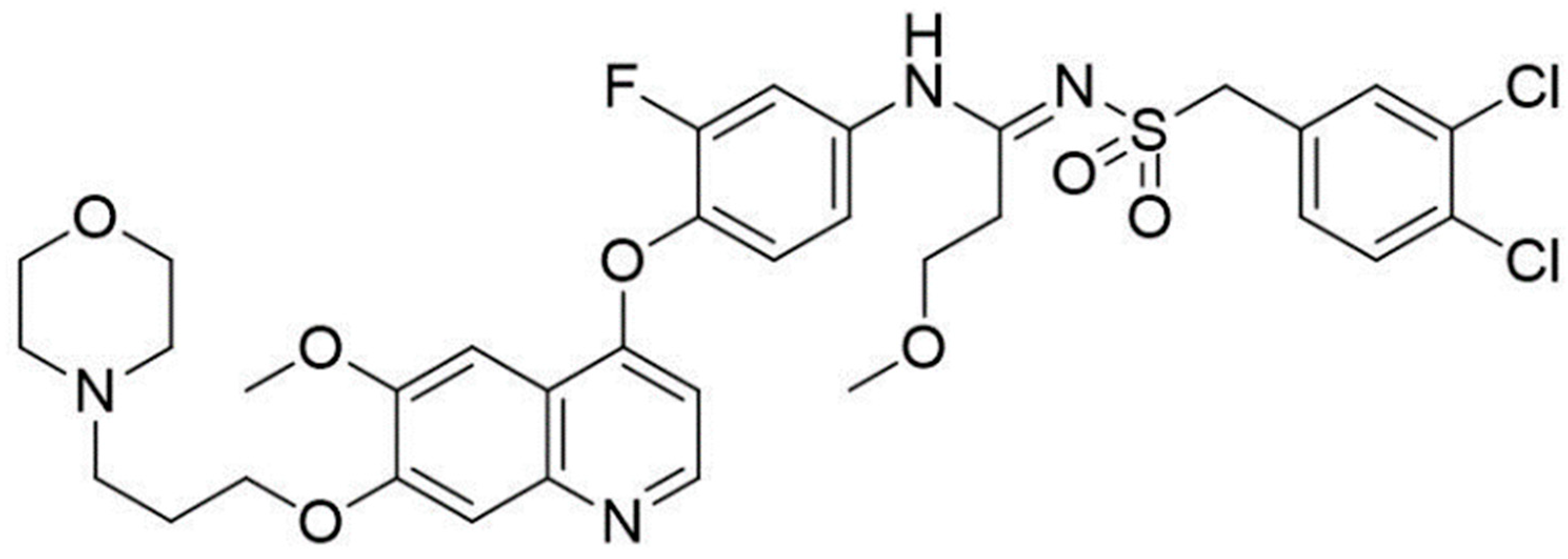
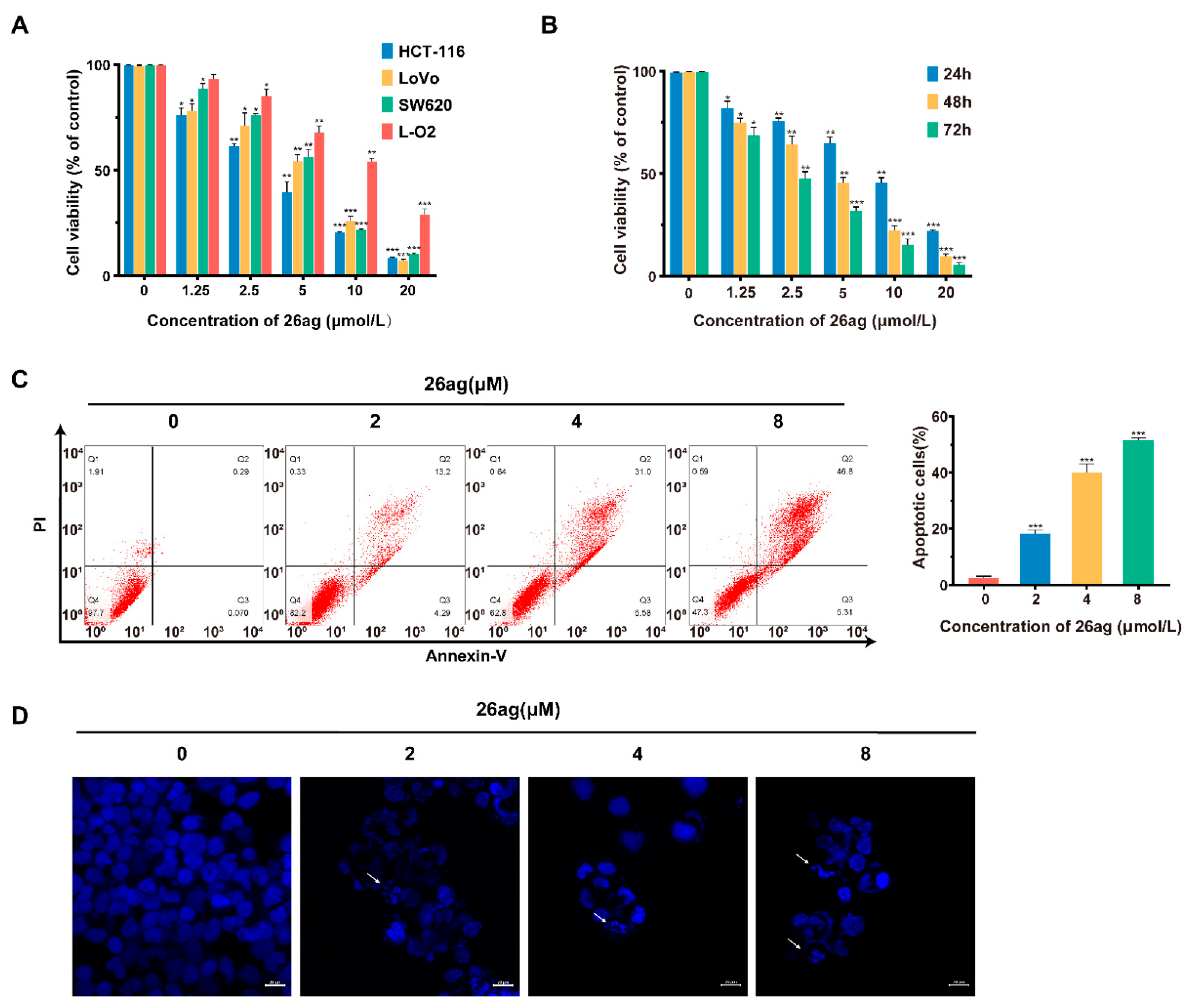
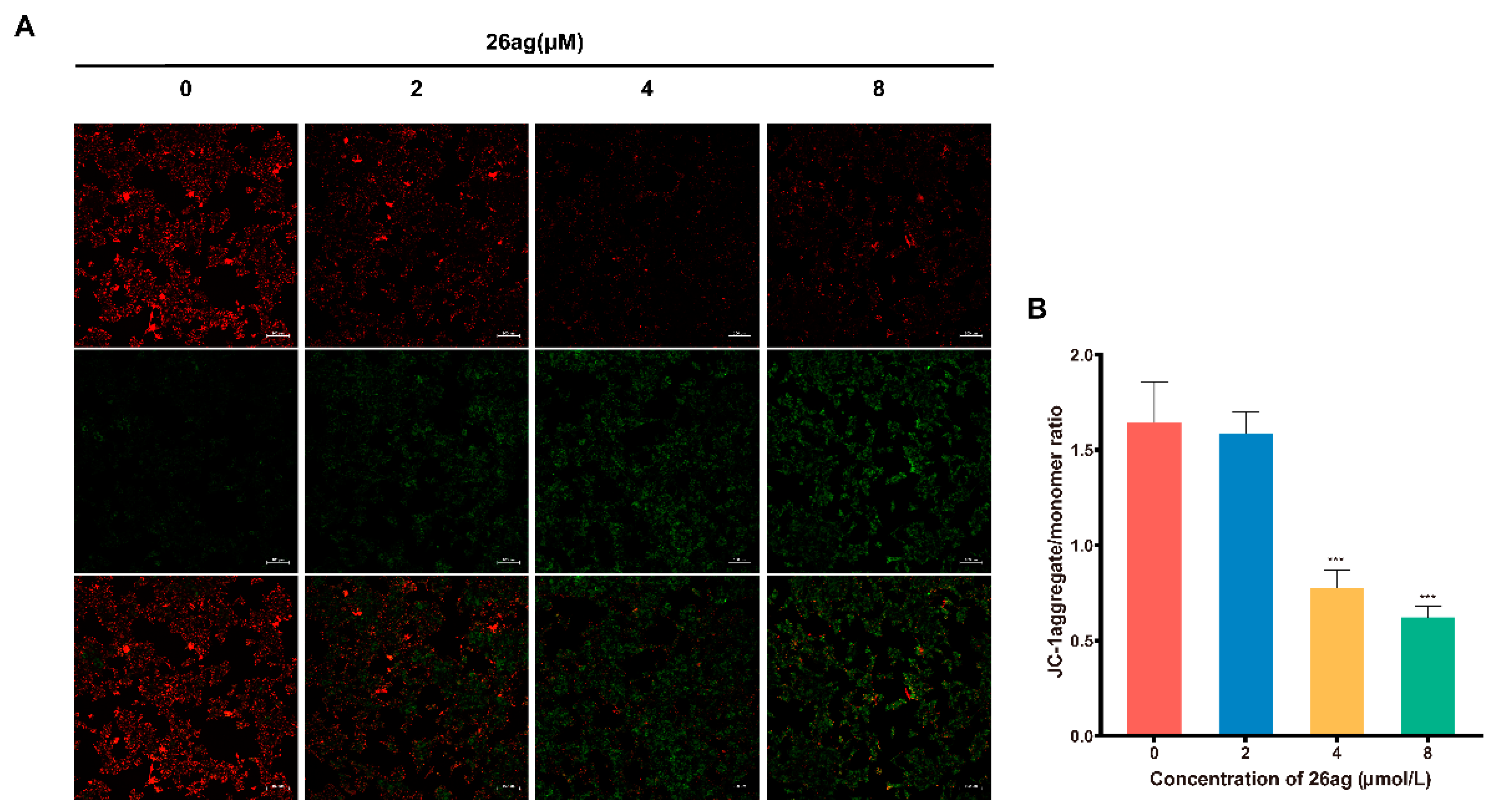
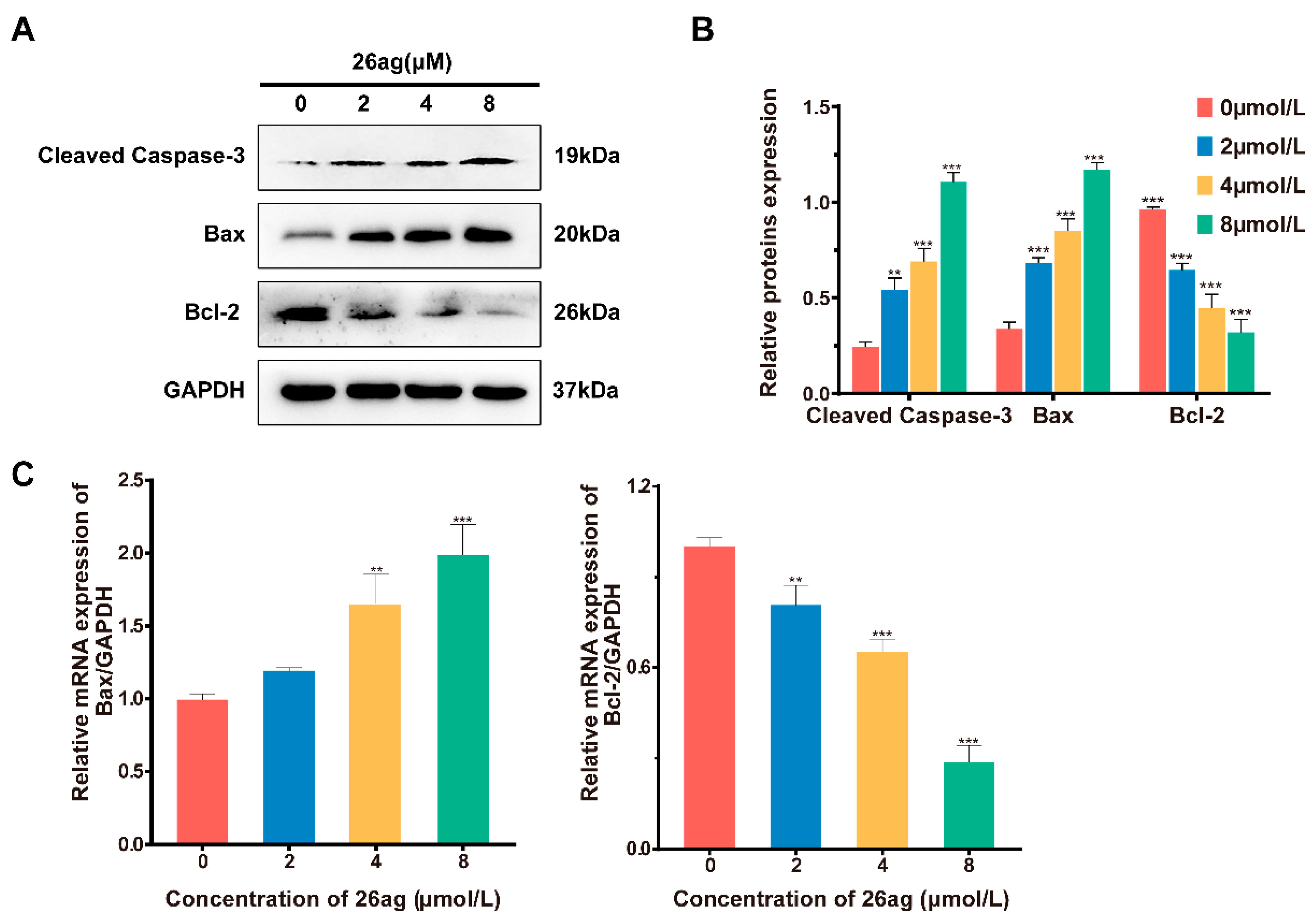
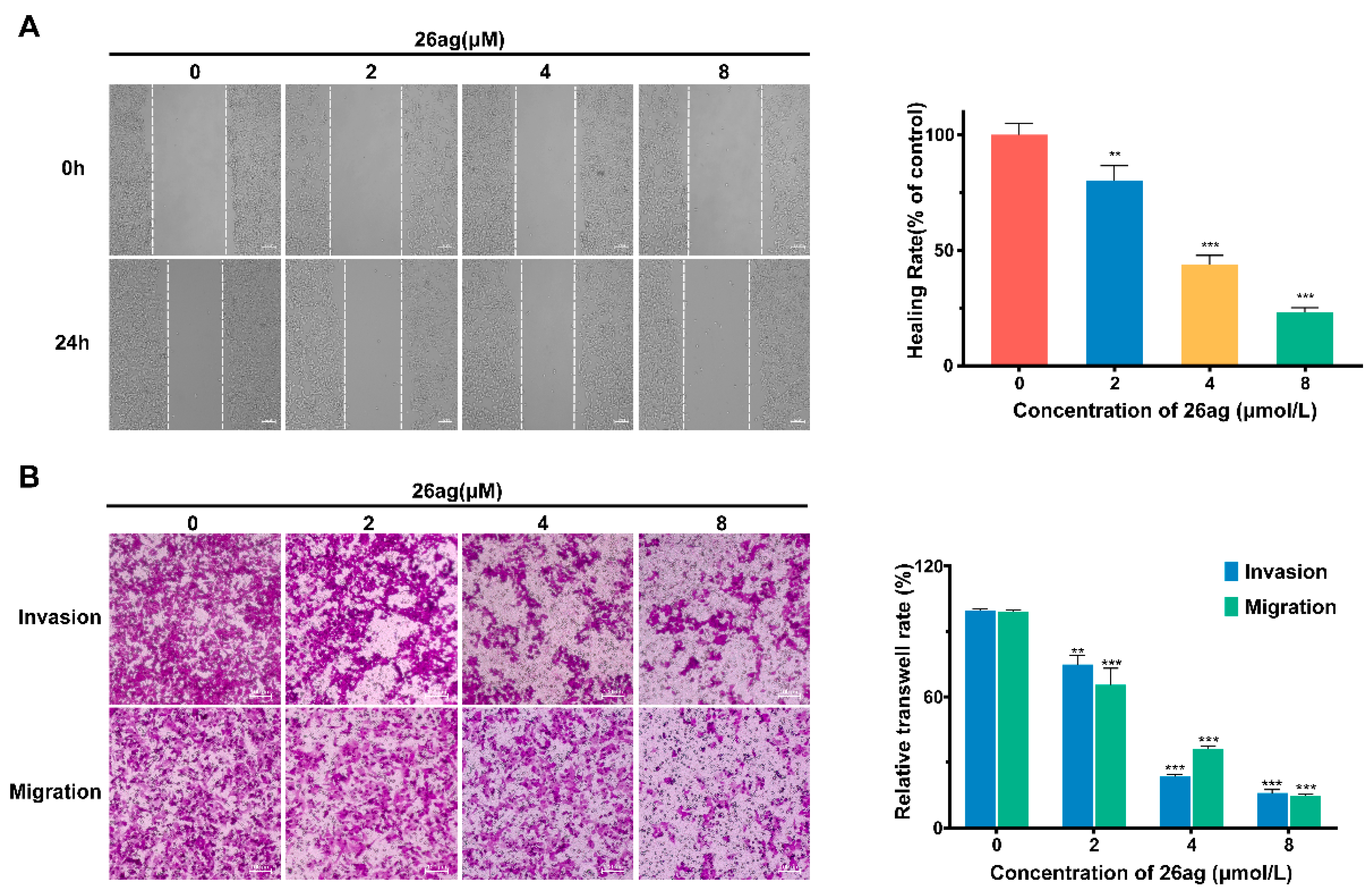
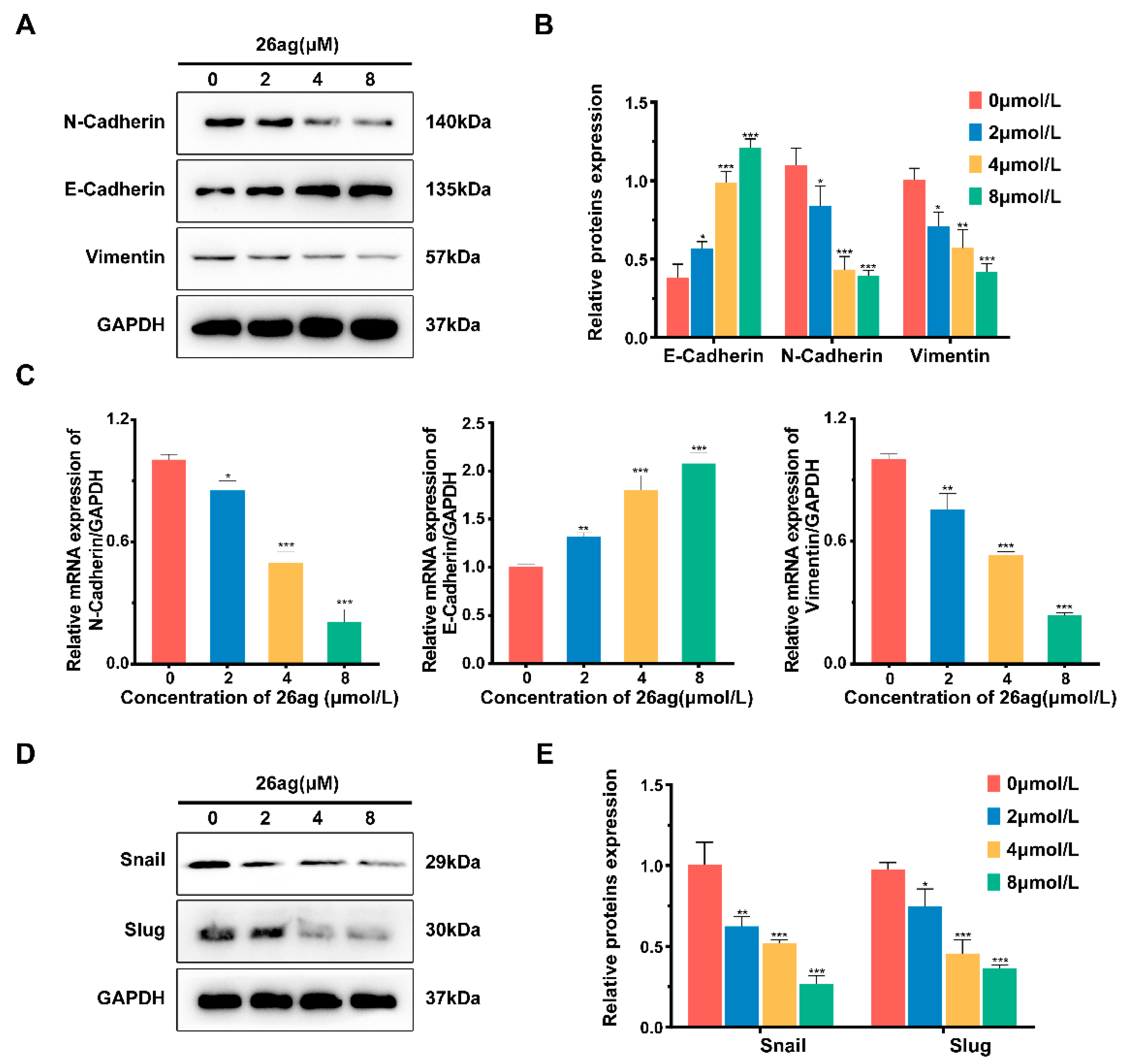


| Gene | Primer Sequence |
|---|---|
| E-cadherin | forward primer:5′CGAGAGCTACACGTTCACGG-3′ |
| reverse primer: 5′-GGGTGTCGAGGGAAAAATAGG-3′ | |
| N-cadherin | forward primer: 5′-CCTTTCAAACACAGCCACGG-3′ |
| reverse primer: 5′-TGTTTGGGTCGGTCTGGATG-3′ | |
| vimentin | forward primer: 5′-GACGCCATCAACACCGAGTT-3′ |
| reverse primer: 5′-CTTTGTCGTTGGTTAGCTGGT-3′ | |
| Bax | forward primer:5′-TCAACTGGGGCCGGGTTGTC-3′ |
| reverse primer: 5′-CCTGGTCTTGGATCCAGCC-3′ | |
| Bcl-2 | forward primer:5′-ATCGCTCTGTGGATGACTGAGTAC-3′ |
| reverse primer: 5′-AGAGACAGCCAGGAAAATCAAAC-3′ | |
| GAPDH | forward primer: 5′-CATCAAGAAGGTGGTGAAGCAGG-3′ |
| reverse primer: 5′-TCAAAGGTGGAGGAGTGGTGTCGC-3′ |
Publisher’s Note: MDPI stays neutral with regard to jurisdictional claims in published maps and institutional affiliations. |
© 2021 by the authors. Licensee MDPI, Basel, Switzerland. This article is an open access article distributed under the terms and conditions of the Creative Commons Attribution (CC BY) license (https://creativecommons.org/licenses/by/4.0/).
Share and Cite
Zhao, X.; Han, Z.; Ma, J.; Jiang, S.; Li, X. A Novel N-Sulfonylamidine-Based Derivative Inhibits Proliferation, Migration, and Invasion in Human Colorectal Cancer Cells by Suppressing Wnt/β-Catenin Signaling Pathway. Pharmaceutics 2021, 13, 651. https://doi.org/10.3390/pharmaceutics13050651
Zhao X, Han Z, Ma J, Jiang S, Li X. A Novel N-Sulfonylamidine-Based Derivative Inhibits Proliferation, Migration, and Invasion in Human Colorectal Cancer Cells by Suppressing Wnt/β-Catenin Signaling Pathway. Pharmaceutics. 2021; 13(5):651. https://doi.org/10.3390/pharmaceutics13050651
Chicago/Turabian StyleZhao, Xingming, Zhuo Han, Jiahui Ma, Shiqing Jiang, and Xia Li. 2021. "A Novel N-Sulfonylamidine-Based Derivative Inhibits Proliferation, Migration, and Invasion in Human Colorectal Cancer Cells by Suppressing Wnt/β-Catenin Signaling Pathway" Pharmaceutics 13, no. 5: 651. https://doi.org/10.3390/pharmaceutics13050651
APA StyleZhao, X., Han, Z., Ma, J., Jiang, S., & Li, X. (2021). A Novel N-Sulfonylamidine-Based Derivative Inhibits Proliferation, Migration, and Invasion in Human Colorectal Cancer Cells by Suppressing Wnt/β-Catenin Signaling Pathway. Pharmaceutics, 13(5), 651. https://doi.org/10.3390/pharmaceutics13050651





